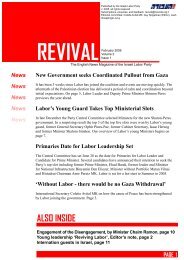You also want an ePaper? Increase the reach of your titles
YUMPU automatically turns print PDFs into web optimized ePapers that Google loves.
The biggest issue for the Bedouin has always been<br />
“land use” and grazing rights rather than formal legal<br />
“ownership” of land. Traditionally, no attention was<br />
paid to the formal ownership of land when Bedouin<br />
tribesmen built temporary structures or grazed their<br />
herds of sheep and goats. For this reason, all Israeli<br />
governments have been interested in having the<br />
Bedouin abandon their nomadic life and settle in<br />
towns. Israel’s security needs in the Negev, especially<br />
the use of land as training ground for the army and for<br />
airports, have often posed conflicts with the areas<br />
grazed by the Bedouin.<br />
The first Israeli Bedouin town, Tel Sheva, was<br />
founded in 1967. Another six towns have been<br />
established since then and the residents of these towns<br />
now account for more than one-third of the Bedouin<br />
population. Much resentment among the Bedouins<br />
has been caused by the urban framework of these<br />
towns that are felt to be too restrictive of their<br />
mobility. The problem remains, however, that the best<br />
way to provide necessary services is to a sedentary<br />
population. The extremely wide gap between Bedouin<br />
living standards and that of the settled Jewish<br />
population has produced new tensions. Children who<br />
formerly took an active part in herding activities are<br />
now idle or forced to attend schools. Part of the<br />
adaptation to an urban life style has led to more<br />
interest in religion and the establishment of a fixed<br />
mosque for the Bedouin population in the regional<br />
capital of Beersheba. This has been viewed with great<br />
anxiety by the Jewish population who fear an<br />
identification of the Bedouin with extremist Islam. All<br />
these factors have contributed to a radicalization of<br />
this segment of Israel’s Arabs.<br />
The Settled Moslem and Christian Arab Population:<br />
The bulk of the Arab population comprises more than<br />
700,000 Israeli citizens who are Muslims and another<br />
150,000 Christians living in villages and towns. In<br />
theory, every Arab child must go to school in Israel<br />
for at least 8 years and Hebrew is taught from the<br />
third grade. Hostility towards Israel has always been<br />
largely due to the experience of being reduced from a<br />
majority both ethnically and religiously to the status<br />
of a minority. The previous confidence of being a<br />
Christian or a Moslem and therefore part of a<br />
prestigious world-wide religious community was<br />
dealt a severe blow by Israel’s independence and<br />
military victories.<br />
The lack of an appropriate framework and symbols by<br />
which the Christian and Moslem population can<br />
identify with the state rather than a specific grievance<br />
based on prejudice is the problem which Israeli<br />
statesmen, educators, philosophers and politicians<br />
have not sufficiently addressed. High school<br />
graduates are fluent in Hebrew after 3-5 hours a week<br />
instruction for ten years. Knowledge of Hebrew is<br />
much greater among men and those who work in the<br />
Jewish sector of the economy outside of the village.<br />
Hebrew is needed for higher education as there is no<br />
university in Israel especially for Arabs. The shortage<br />
of appropriate skilled jobs for Israeli Arab university<br />
graduates has always been a primary factor in<br />
antagonisms and resentment towards the state. A<br />
successful Israeli Arab who writes in Hebrew is Anton<br />
Shammas, author of the critically acclaimed novel,<br />
Arabesques, but his work and name are totally<br />
unknown among Jewish communities abroad, and<br />
within Israel he is regarded with suspicion by both<br />
communities.<br />
Before the Intifada, and even recently, there have<br />
been severe tensions between Muslim and Christian<br />
Arabs over the construction of a new mosque adjacent<br />
to the monumental Catholic Cathedral in Nazareth.<br />
These differences will surely re-emerge just as the<br />
tensions between secular and ultra-orthodox or<br />
Ashkenazi and Sephardi Jews, now dormant, will also<br />
need to be faced and resolved in a sense of common<br />
civic responsibility once the present crisis has<br />
subsided. All are hyphenated Israelis. The challenge<br />
of the future is to increase the Israeli part. Those who<br />
are afraid of equal rights have always insisted that<br />
even Israel's "loyal" non-Jewish citizens have acted<br />
only opportunistically and are not motivated by the<br />
same feelings of loyalty and patriotism. Yet these<br />
same critics do not apply that standard to measure the<br />
disloyalty of some Jews who customarily avoid all<br />
civic obligations. Instead, they often argue the cause<br />
of some "higher morality" such as preserving the<br />
modesty of women or devotion to the Torah.<br />
Continued on page 24<br />
12 JEWISH FRONTIER<br />
Summer 2004




